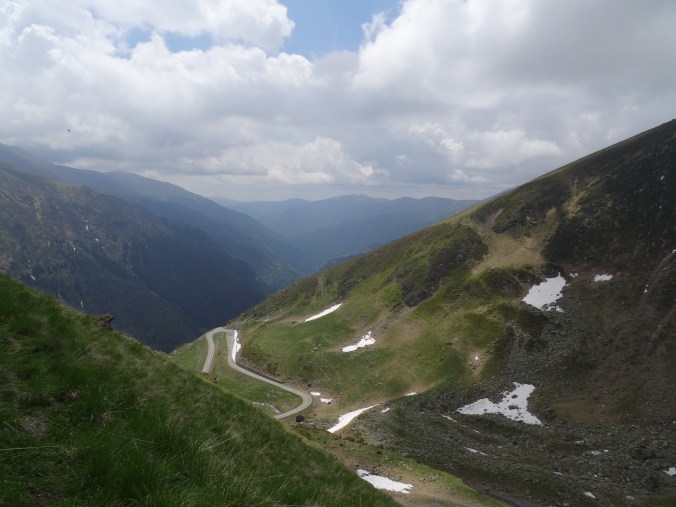I spent a week driving around Romania in May 2017 and it was a completely awe-inspiring trip. This page covers the write up of my whole trip, including some tips for your own visit.
Day 1 – arrival in Cluj-Napoca
The outskirts of Cluj are more sprawling than I had imagined and between the traffic and numerous junctions it felt a long drive from the airport, even though it’s only around 15- 20 minutes.
The urban sprawl is quite built up, with a few pockets of tower blocks. One you get into the old town it feels more like the type of chocolate box kind of Central / Eastern European town you expect to see with bars, outside eating and lots of differently coloured buildings lining cobbled streets.

Pretty houses in Cluj-Napoca’s historic centre
I was expecting a sleepy little town, but it was really buzzing for a Sunday night, possibly because of the Transylvania film festival which is held in the last week of May…or because Romanians just like to party on Sunday nights.
 Dinner time meant my first local beer, an Ursus (Bear beer!). It was fairly pleasant but won’t be making my list of the best beers of the world (to be published shortly). We sat outside while a band played at the other end of Piata Muzeului.
Dinner time meant my first local beer, an Ursus (Bear beer!). It was fairly pleasant but won’t be making my list of the best beers of the world (to be published shortly). We sat outside while a band played at the other end of Piata Muzeului.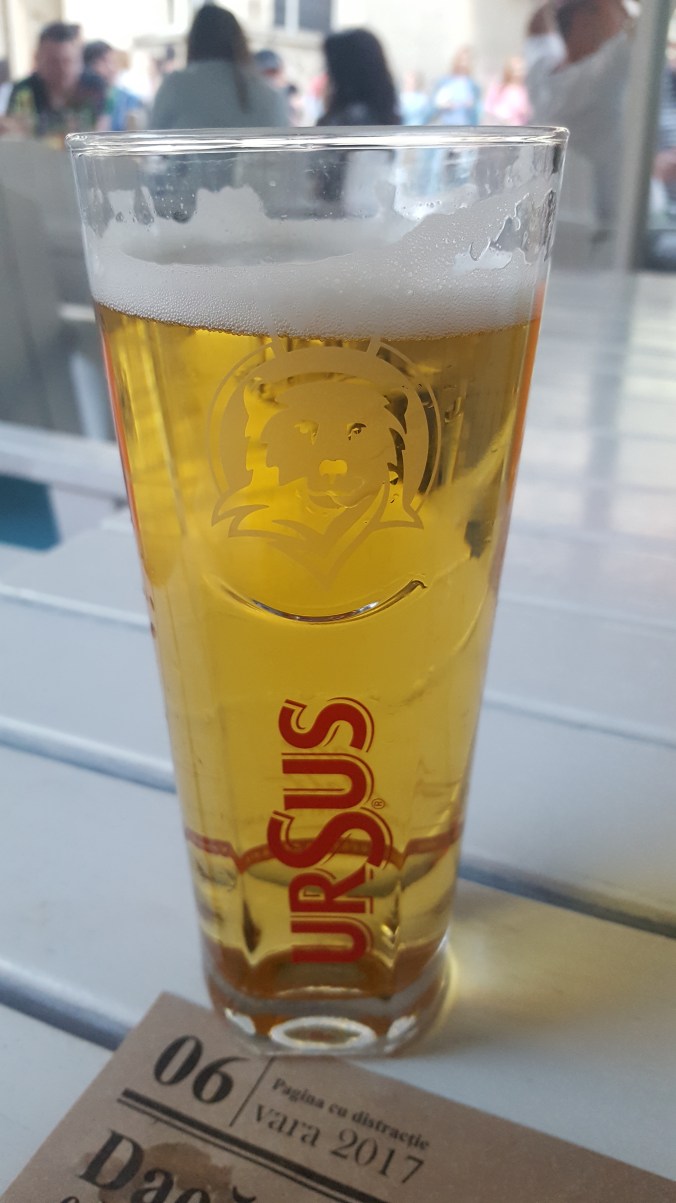
Day 2 – the Carpathian Mountains
My first full day in Romania started with a walk around the centre of Cluj. We headed to the main square Piata Unirii to see the town’s 14th century St. Michael’s Church which towers over the square despite the vastness of Piata Unirii.

Cluj-Napoca’s St. Michael’s Church
The inside is plain but impressive with stained glass lighting up the apse and some remnants of 14th – 15th century frescoes survive in the nave and the Scheyling Chapel.

Remnants of 14th century wall painting in Cluj-Napoca’s St. Michael’s Church

It’s a pretty walk around Cluj which is a jumble of colours and architectural styles. My itinerary didn’t allow for much longer there so I didn’t explore any of the many, many museums on offer or get to sample any more of the restaurants. I was left with the impression you could easily spend a couple of busy days there.
After an hours walk around the town we hit the road for a 200km jaunt across Transylvania, crossing the Carpathian Mountains through the Borgo pass (Tihuta pass to Romanians), made famous by Bram Stoker’s Jonathan Harker, who crossed the winding and rocky pass in Count Dracula’s mysterious carriage. 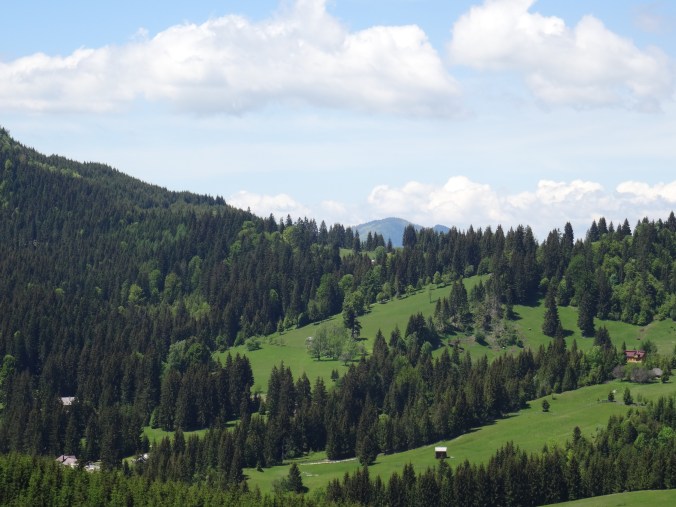
The first half of this journey is disappointingly congested (vs expectation…not on the scale of London!) And lacks any seriously stunning monuments or views. However, you pass through a number of larger towns where you can stop for something to eat or to explore. The route takes you through Bistrita, a Saxon town of cobbled streets and a 14th century cathedral. It would make a good base to break up the journey to Moldovita if you have some free time.
Having expected the Carpathians to be dark and brooding like their portrayal in Dracula, I was surprised to find what was more a rolling alpine hillside dotted with cutesy wooden houses and sheep than the stuff of nightmares.

Houses in the the Carpathian Mountains, Romania
It was, however, a spectacular journey of winding roads with amazing views across the valleys. The roads are in pretty good shape (not so for the rest of the country we were soon to discover), and while it’s slow going zig zagging up and down mountains, it wasn’t nearly as treacherous as I had hoped! Perched at the very top is the Hotel Castle Dracula, positioned where the castle stood in the book. We didn’t look around but it sounds like a kind of Disney does Dracula affair, albeit with breathtaking views.
After more twisting and turning we finally made it to the tiny and pretty little town of Moldovița where we would stay for the night as a springboard for our tour of the Bucovina painted monasteries.

Haystacks in the Carpathian Mountains
We stayed in a little wooden pension, the Vila Crizantema. Our host was great and although she spoke little English, was inviting and helpful and cooked us some great food. I wholeheartedly recommend staying here for the food, nearly all of which- butter, cheese and ham- is homemade.
Dinner was a delicious chicken soup (a sour soup typically called a ciorba or a borscht) followed by some pork with a tomatoey gravy and potatoes. Everything was laden with butter – amazing.
Day 3 – Moldovița and the Bucovina monasteries
Driving tour of the four major monasteries:
Moldovița monastery is a 5 minute walk from Vila Crizantema so we went to visit the afternoon we arrived. It costs 5 lei to enter and you can take photographs outside but not inside. You can’t wear short or skimpy clothes in the monastery complexes. Even men in shorts (if they’re above the knee) will be given a little wrap to wear.

The fortifications around Moldovita monastery, Romania
Moldovița church was built in 1532 and decorated in 1537. It sits within a fortified monastic complex. The decorative scheme has yellow as the dominant colour (each monastery has its own decorative colour scheme) and takes for its adornment a very similar scheme to the other big monasteries in Bucovina. 
The southern exterior shows the 626 siege of Constantinople towards the west end with the center of the south wall taken up by a huge tree of Jesse. 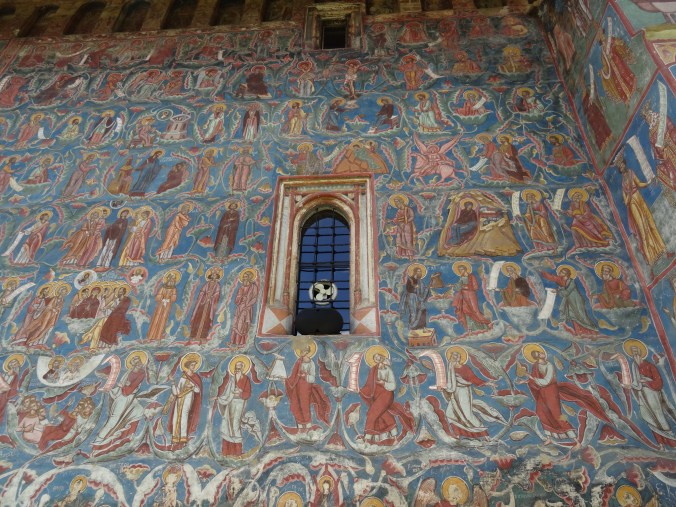

South wall, the siege of Constantinople, Moldovita monastery
The porch at the west end of the church features a huge and intricate ‘doom’, a representation of the last judgement, with the righteous to Jesus’ right hand side and the dammed to His left.

The West porch of Moldovita Monastery in Bucovina showing a ‘Doom’ or Last Judgement painting
The grounds around the church are beautifully manicured with plants climbing up the fortifications. There’s also a small museum on site displaying a range of artifacts from the monastery’s history.
After an excellent night’s sleep in our cute alpine style room, we were off to see the rest of Bucovina’s monasteries. According to the rough guide, this is a little visited part of Romania, probably owing to its remoteness from any of the major airports.
It is totally worth the journey, the painted churches are completely unlike anything I’ve seen anywhere (and I’ve seen a lot of churches). The decoration covers every inch inside and out and everything is painted with a remarkable level of consistency. Hundreds of small squares representing Bible and Apocryphal stories stare down at you from the walls, with a slightly overwhelming number of depictions of beheadings (!).

Sucevita monastery seen through the fortified entrance gate
The grandest of the monastery complexes we visited was Sucevița monastery which sits in a large fortified complex.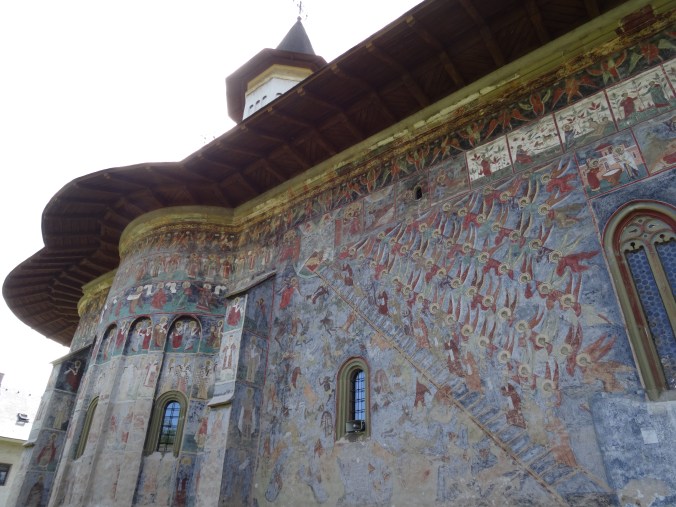

The decorative scheme is in blues and greens and the most striking of the paintings is the huge Jacob’s ladder which takes up nearly the whole North wall with row after row of uniform angels in different colours. The inside is equally awe-inspiring with hundreds of pictures of Saints’ lives dotted across ever inch of interior.
Humor monastery is the smallest of the monasteries I visited and has a reddish-brown as it’s signature colour. It also includes a large Last Judgement scene in its decorative scheme.

Humor Monastery with its distinctive reddish brown colourings, Bucovina
The grounds are a bit smaller than the others but there’s also a watch tower you can climb up for views over the countryside. Just be aware that it is extremely steep and very narrow. You can also see daylight through the boards which make up the wooden platform around the top, so if you’re not a fan of heights you might want to give it a miss! Humor also charges 5 lei for entry and 10 lei to take photos.

Watch tower at HUmor Monastery
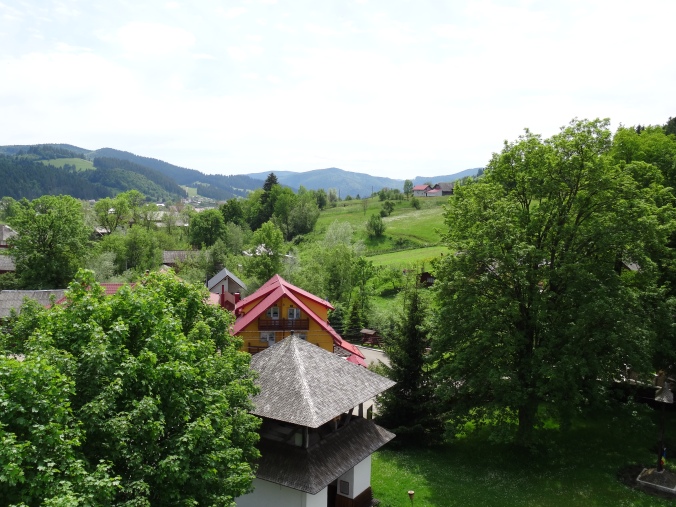
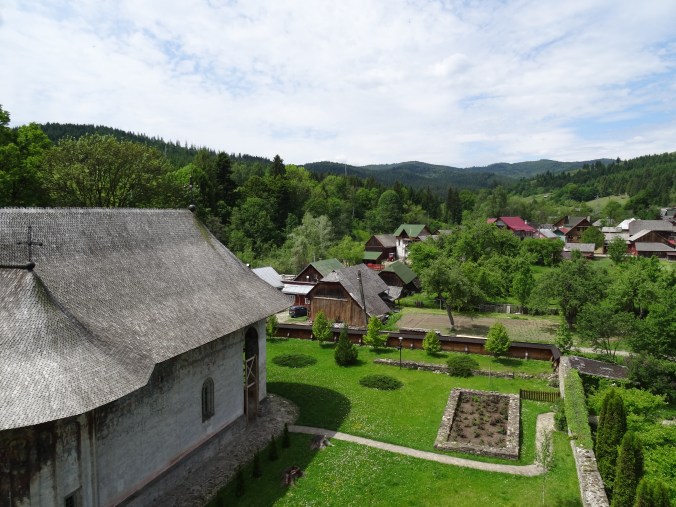
View of the monastery from the watch tower at Humor Monastery, Bucovina
Voronet Monastery is close to Humor although much lager in scale and is reputed to have been built in under 4 months. It has a blue signature colour scheme which is so renowned that it’s called ‘voronet blue’.
The most striking feature of Voronet is that instead of a West door, the west exterior wall has no openings and is instead covered by the most vivid and spectacular Last Judgement. Particularly striking are the neat rows of clergymen destined for paradise whose orderly and geometric depiction represents their piety.

Last Judgement scene on the west wall of Voronet Monastery with distinctive blue colouring

Detail of the Last Judgement scene at Voronet Monastery
Benches are laid out so you can sit and study the painting for a while. This was probably my favourite of the monasteries due to the scale and detail of the Last Judgement painting.
After the Bucovina monastery tour it was a few more hours in the car headed south towards Lake Bicaz, also known as Lacul Izvorul Muntelui. The roads in this part of the country are terrible and we spent the best part of one hour bumping and jarring from pot hole to pot hole. There isn’t really a way around this, you just have to slow down, but vigilant and sometimes just brace for impact.

One of the many stork nests on a telegraph pole
You’re rewarded for your driving efforts by mile after mile of unspoilt forest and rivers and a parade of charming little towns and villages. The most fascinating thing is to watch all the locals at work. Out in the countryside it seems that the overwhelming majority are farmers and even those that aren’t seem to keep a few animals and grow their own vegetables. Every town and village also has a resident stork or five with huge nests built atop telegraph poles.
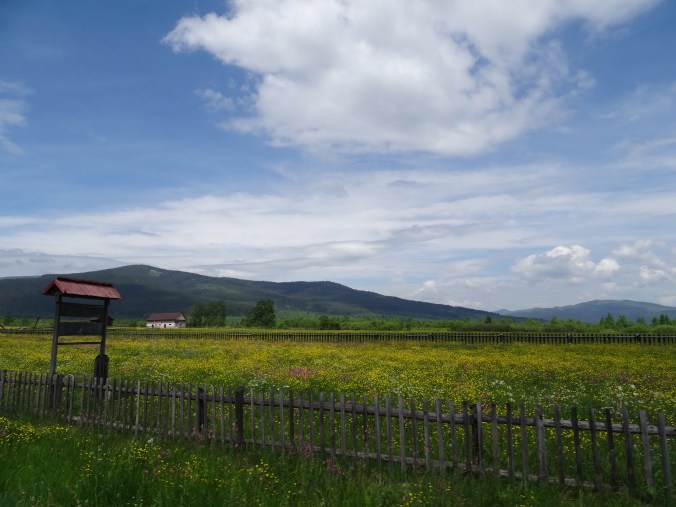
Meadows on the way from Humor to Lake Bicaz
Dotted across the landscape and far up into the hills stand pitched wooden barns which we were told were to house hay for the animals through winter, it being more convenient to have supplies up in the hills near where the animals graze than at home.
Neat haystacks line the road throughout the countryside and sheep, cows, horses and chickens wander the mountains and the verges grazing at will. Everyone drives pretty fast in Romania but it’s wise to take account of the speed limits through bad roads and towns and villages. A lot of life happens on or around the road in Romania and you frequently come speeding around a corner to find a dog, horse and cart or child merrily wandering in the street.
The last leg of our journey took us down a treacherous steep and rocky trail to our accommodation. We stayed a few hundred meters from Lake Izvorul Muntelui, which is a man made lake resulting from a damn at the southern end of the lake.
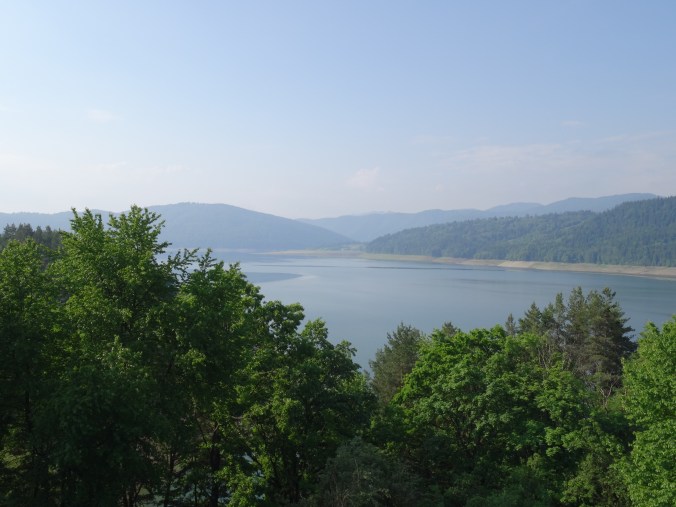
Panoramic view of the man made Lake Izvorul Muntelui from our lodgings, Neamt County
I tried a Moldovitan traditional dish for dinner called Tochitura- a combination of polenta, fried eggs, cheese, red onion and several types of pork (mine came with bacon, sausage, liver and just plain old pork). Pork seems omnipresent in Romanian cooking but it was the only animal not spotted on our trip!

Pork overload with traditional Moldovitan Tochitură

Day 4 – Lake Izvorul Muntelui to Sovata
The day’s route from from our lodgings in tiny Buhalnița, Neamț to the lively spa town of Sovata:
After a really heavy thunderstorm in the evening and overnight, it was a fresh morning on the lake. After an omelette that was more bacon than egg (turns out you can have too much of a good thing), we decided to leave early and head to our next destination.
I had originally imagined staying the day at the lake for swimming and sunbathing, but the accommodation turned out to be rather shabby and less well equipped than I had expected so we decided to take our chances at our next stop, the town of Sovata. The views from our hotel, however, were amazing despite the sorry state of the interior. It was set back about 100m from the lake and perched on the steep hill that led down to the water.

Panoramic view of the man made Lake Izvorul Muntelui from our lodgings, Neamt County
An unexpected bonus of our route through Lacul Bicaz to Sovata was the scenery through the Bicaz Gorges. I hadn’t planned this at all and was unaware of their existence until we started our journey and I leafed through the guidebook to see what we might pass on the way.
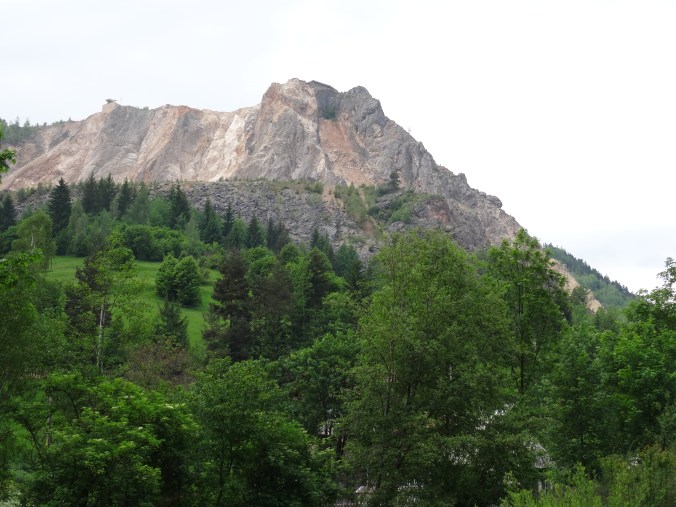
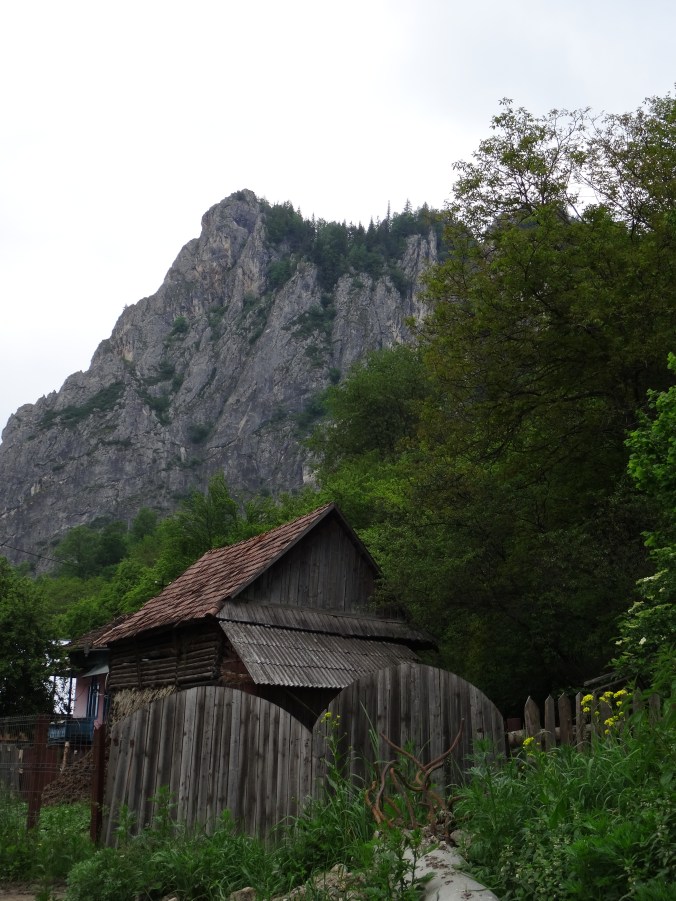 The Bicaz Gorges are not to be missed. Impossibly high sheer cliffs rise up on each side of you through a series of hair pin bends. Pine trees somehow cling to the rocks in patches and some of the rocks form overhangs across the road forming half of an arch (the so called “Neck of Hell”). We had to keep stopping to take photos, it was such a dramatic drive and I was so glad to have accidentally found it.
The Bicaz Gorges are not to be missed. Impossibly high sheer cliffs rise up on each side of you through a series of hair pin bends. Pine trees somehow cling to the rocks in patches and some of the rocks form overhangs across the road forming half of an arch (the so called “Neck of Hell”). We had to keep stopping to take photos, it was such a dramatic drive and I was so glad to have accidentally found it.
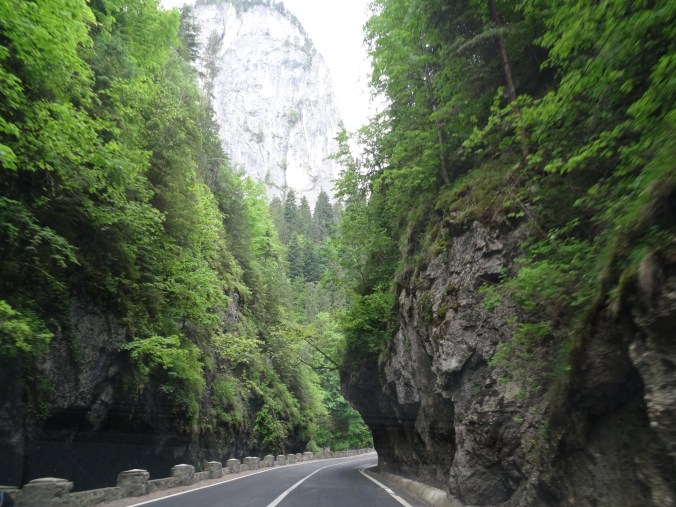
The towering and overhanging rocks in the Bicaz Gorge

After the rocky gorges, the landscape starts to flatten out into plains full of meadow. It was a slightly odd feeling after several days of steep and winding mountains to drive on a straight, flat road lined only with flowers and storks’ nests.
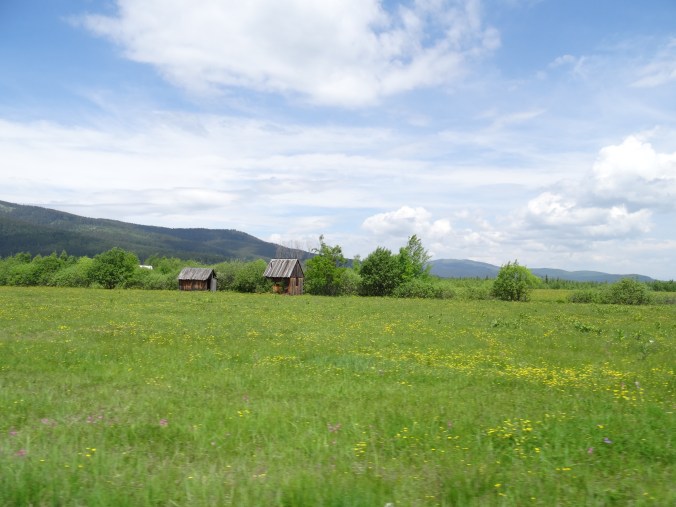
Meadows and tiny hay stores
Sovata is more or less bang in the centre of the country and is a holiday town for Romanians and other Europeans (although it did not appear to be an area frequented by Brits). It contains Europe’s largest heliothermic lake, Lacul Ursu (‘Bear Lake’). The effect apparently occurs when the salt in the lake (which comes from the surrounding earth) settled to the bottom leaving a few inches of water at the top which acts as lens heating up the water in the lake.
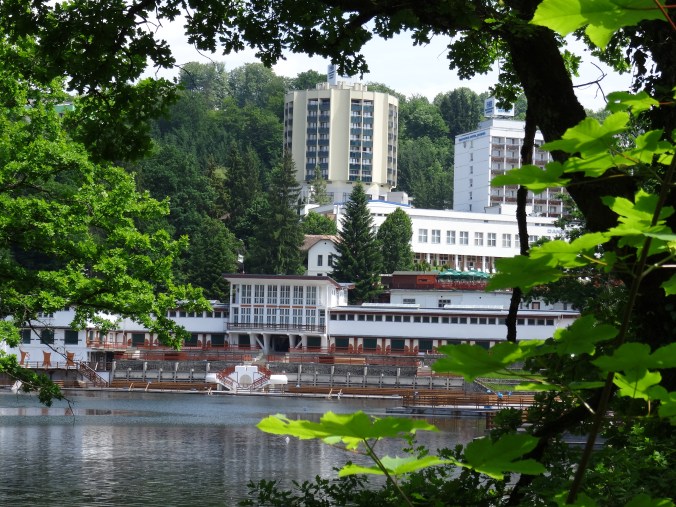
The heliothermic Lacul Ursu, ‘Bear Lake’ in Sovata
Sadly the lake was closed until ‘proper summer’ (even tho it was already 24 degrees…enough for any Brit to swim in). The alternative was the lakes that are open year round including a dirty brown lake full of healing salt and other elements (or mud and leaves) which an older chap in Speedos was enjoying.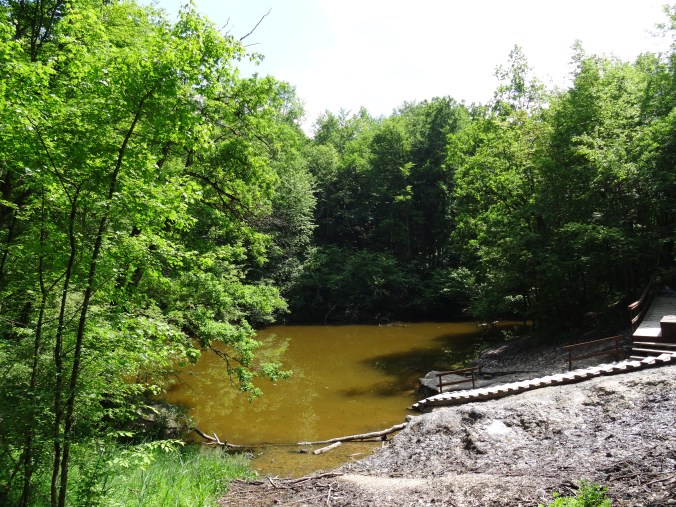
There are lots of nature trails around the lakes and hills in the area with viewing platforms, exercise equipment and information boards about the local floral and fauna, which makes it a pleasant place to spend the day wandering around with plenty to keep children entertained. It’s mostly shaded under trees so it’s pleasant even when hot.

One of the smaller lakes in Sovata

Wooden church in Sovata
Dinner was in the restaurant Ciuperca Mica Kicsi Gomba (which I believe means ‘the little mushroom’), which was well rated on tripadvisor and overlooks Bear Lake. We had a pretty decent meal there (although nothing amazing); soup followed by a salmon fillet on a bed of rocket and lambs lettuce washed down with a Timisoreana beer. The bill for two courses and a beer each was about 16 pounds.

Timosoreana beer
I watched the sun set over the mountains from the balcony of Hotel Relax Sovata. A nice clean, good value hotel with a smart bathroom. Shame there was building work going on (from before 7am!) Right outside the hotel. The position is good, hanging above Sovata which gives you a 10 to 15 minute walk down into town, but it’s quite steep on the way back up.

Sunset over Sovata
I thoroughly enjoyed Sovata and could imagine spending a few days there. It would make a good rest stop on a longer road trip round Romania to have some time off driving. It also gives you an interesting insight into a Romania “seaside” town.
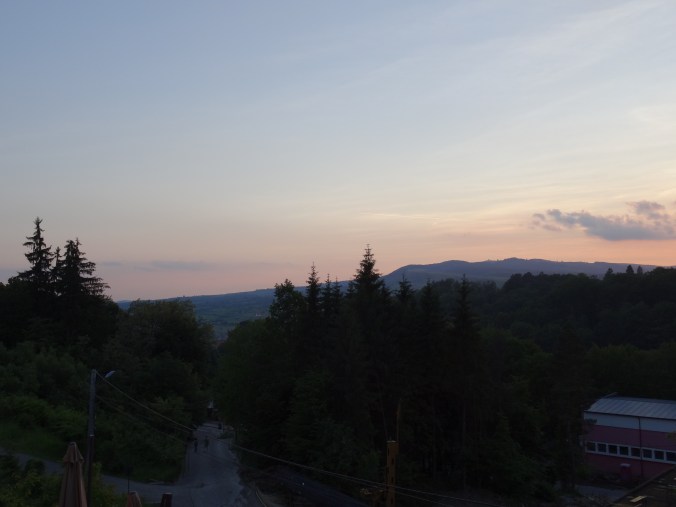
Sunset over Sovata
Day 4 – Sovata to Măgura
From Sovata we headed south cross country to Măgura where I had a booked a stay in the mountains with a trip to a bear hide. I’d been waiting the whole trip for the chance to see bears doing their thing in the woods, so this day went so slowly as my anticipation built! I booked the bear watching through Carpathian Nature Tours, staying at the Villa Hermani.
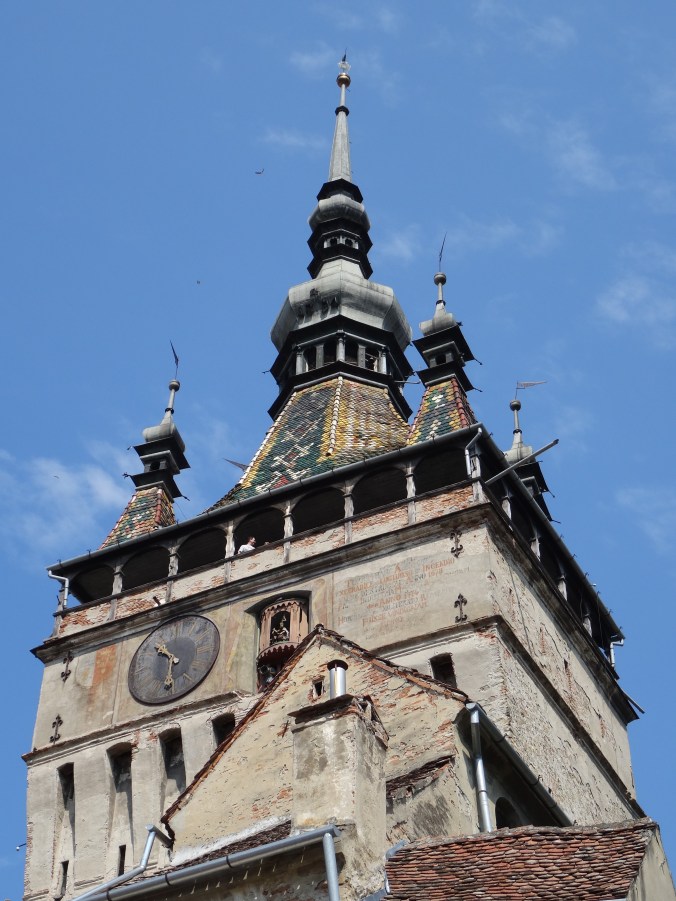 Our first stop for the day was in the 12th century town of Sighișoara in Mureș County. A popular stopping point for tour groups due to its unbelievably picturesque architecture and cute cobbled streets.
Our first stop for the day was in the 12th century town of Sighișoara in Mureș County. A popular stopping point for tour groups due to its unbelievably picturesque architecture and cute cobbled streets.

Coloured houses, Sighișoara

Coloured houses line a square in Sighișoara
Oh yeah, and Dracula was legit born here. In 1431, Vlad Tepes was born in the house his father, Vlad Dracul lived in and stayed there until 1435. The house is brightly painted in yellow, which seems an odd contrast with the myth of Vlad’s later years.

Birth place of Vlad Dracul in Sighișoara
Sighișoara is well worth a stop, it’s quite a large place outside of the old medieval town, which boasts a beautiful clock tower which you can climb, plenty of highly instagrammable streets and a few interesting churches.

The gospel church, Sighișoara
After wandering around for an hour we headed for Măgura where the bears would be (hopefully) waiting for us. The journey was a more or less flat but rather narrow and twisty affair in places, taking us through yet more tiny towns and villages.
The end of the journey was a white knuckle ascent of a hair-pin unpaved mountain road of considerable grade. With just the huge trees each side to catch the car if our wheel caught the edge of the gravel, I clung onto the door and didn’t take a single picture.

A hillside in the town of Măgura in the Piatra Craiului National Park
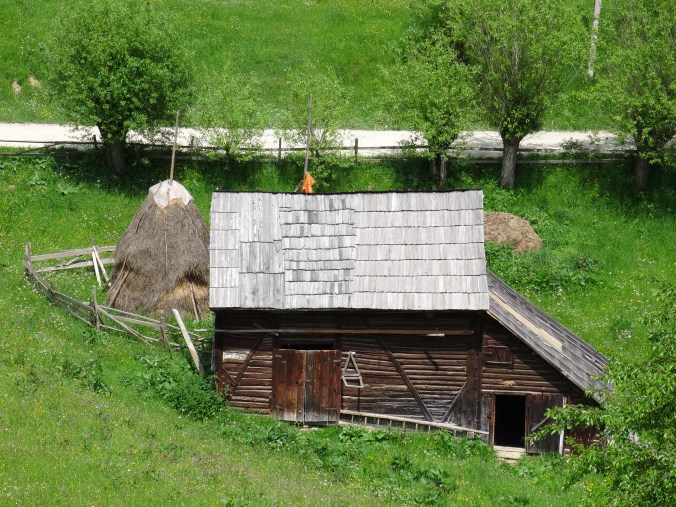
I had thought there would be little but the villa at the top of this treacherous climb, but in fact there was a rather large and spread out village at the top amongst verdant rolling hillside. The views across to the distant Făgăraș Mountains were spectacular and there was a wonderful quiet about the place (except for the incessant barking of guard dogs!).

Măgura with mountains in the distance
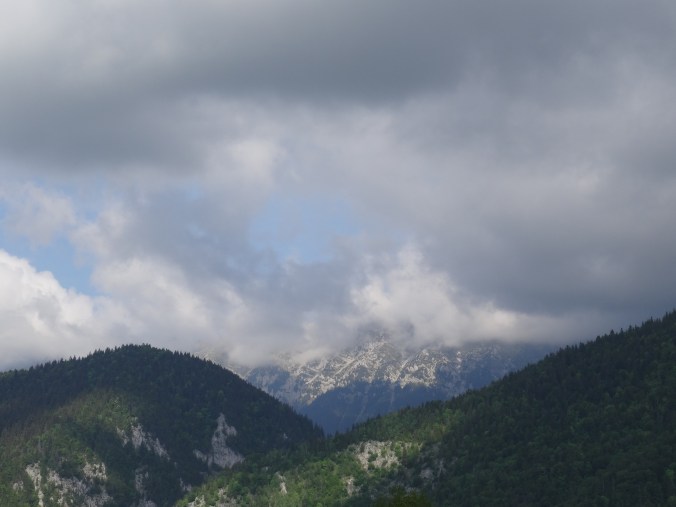
The distance Făgăraș Mountains loom over Măgura
Bear watching was prefaced with a disappointing soup (not really what you want when you’ve been told there are no toilets available until you get back around 9pm) and then we bundled into a minibus like a really exciting school trip. Rather annoyingly it was a one hour drive to the bear hide (although we were allowed to pee in the woods before we went to see the bears- yay!). It meant heading back down the steep and winding gravel road back the way we had come up just an hour previously. Our driver was rather less cautious and we bumped and lurched the whole way down in the rickety bus.
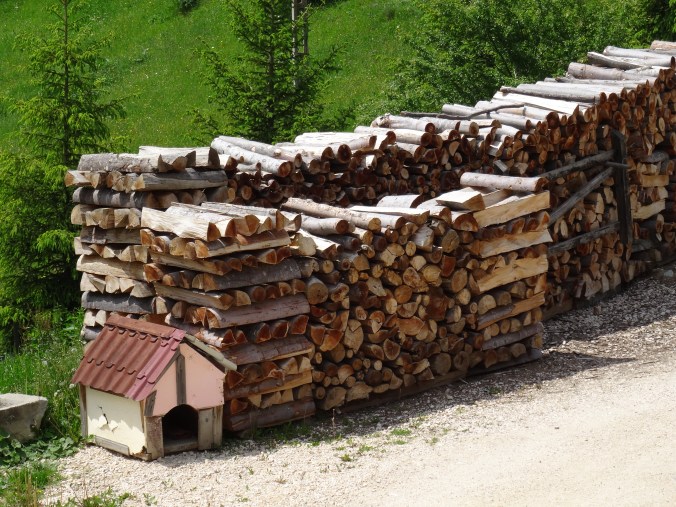
Incredibly neat woodpile at Villa Hermani, Măgura
After an hour winding up and down mountains we pulled off into a nondescript layby to meet up with another car load of bear sighting hopefuls then quickly forded a deep river (as you do in an old minibus) and headed off road into the woods.
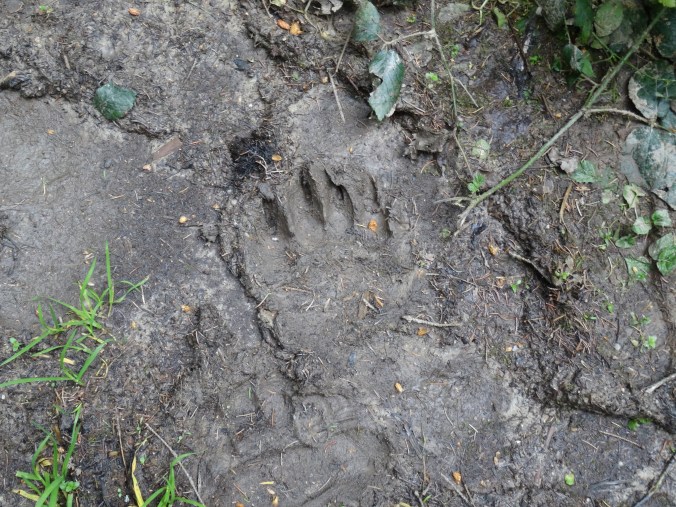
Our first evidence of bears – a paw print!
After about 5 minutes we pulled up and got out to walk the rest of the way to the hide. It felt so exciting and also slightly scary knowing that somewhere out ‘there’ were bears, maybe listening to us and watching us walk along. On the short walk to the hide we encountered our first evidence of bears, huge paw prints pressed into the soft mud. 

Baby bear makes off with a snack
As we entered the hide we saw the bears already in place, feasting on the snacks left near the hide to draw them in. We crept quietly in so not to disturb them and there they were, a mother and her two cubs to one side, and a huge male sat on a log. The mother was much darker than the male with a white patch on her neck. The baby bears were gambolling about together but ever mindful of the big male bear, shooting wary glances in his direction the whole time.
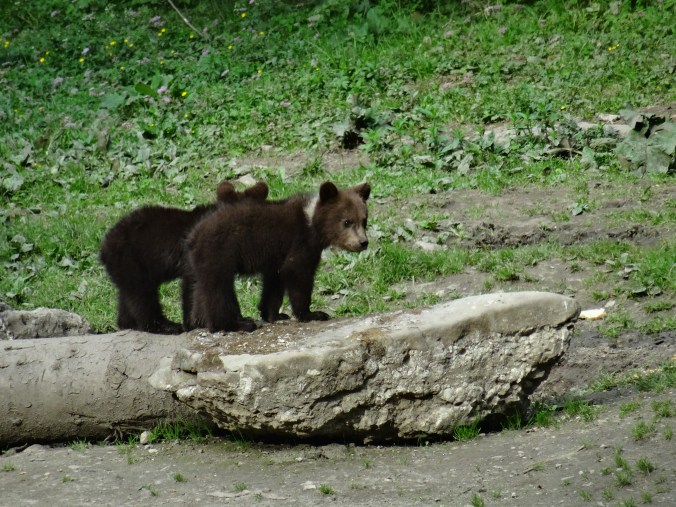
Glancing warily at the male bear

Male bear pulling his ‘teddy bear’ pose
After various comings and goings (and about 200 photos) we’d seen about 6 different bears, far more than I had ever expected.

Big male bear guards his log
We left the hide to head back to the minibus and the hour long trip back to Villa Hermani. Dinner was get what you’re given and we were served some indifferent veal, a salad and some delicious mashed potatoes. Starter and dessert had been eaten before we left, so that was our lot and I went to bed slightly hungry.

Two bears tuck in
I had a slightly restless nights with the constant barking of dogs outside, presumably repelling the advances of all manner of bears and wolves. It was strange looking out into the pitch black of the mountains and wondering what was out there. The morning brought beautiful sunshine and more spectacular views. After enjoying a few cups of tea in the sun it was once again time to hit the road…and back down the gravel hair-pin route.
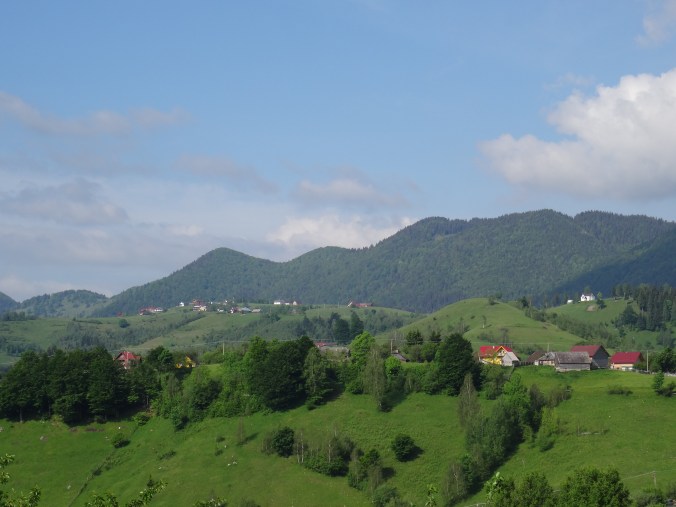
Rolling hills in Măgura in the Piatra Craiului National Park
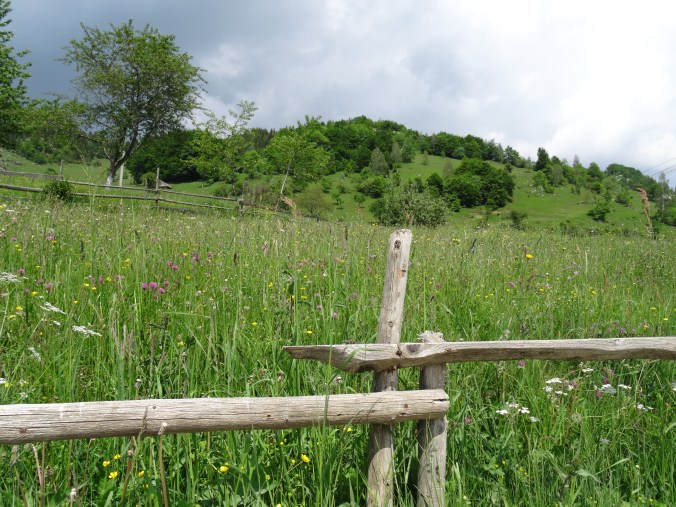
Meadow and wooden fence posts in Măgura
Day 5 – Măgura to Curtea de Argeș, via Brașov and Bran Castle
After bumping back down the gravel track from tiny Măgura, we headed to Bran Castle. Despite only tangential associations with Vlad the Impaler, the castle is general known as ‘Dracula castle’ and there are all manner of themed restaurants and gift shops outside the gates.

Bran Castle
Bran came as rather a culture shock after several days touring the Romanian countryside. Due to the relative ease of access for tourists arriving in Bucharest, Bran is mobbed by bus loads of tourists swarming around its narrow corridors. I can see how it might have been a rather interesting visit under different conditions but I did find the crowds rather overwhelming as we were effectively having to stand in a long queue to get into the next room.

Bran Castle near Brasov
The castle has a long and chequered history, having changed hands multiple times and being used as a fortress, a residence and as a WWII hospital during its time.
It’s nice to visit a Romanian castle but for me the crowds really did ruin it. Once we got o Rasnov, a bigger and more imposing fortress, I was excited to see something rather more gritty and less Disney does medieval, but finding the car park solid with cars and even busier than Bran, we decided to skip it.
Perhaps coming earlier in the day or a different time of year would have helped, but unfortunately I don’t like to be bothered with crowds and queuing on holiday (probably a side effect of living in London) so we decided to cut our losses and move on.
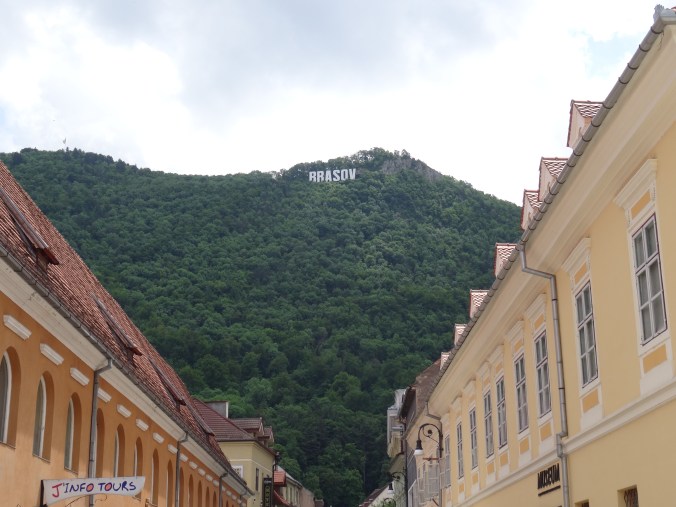
Brasov!
Brașov is an extremely pretty town, which I would have happily spent a couple of days in rather than a couple of hours. It announces itself with a giant Hollywood-esque sign (and do a few other landmarks in Romania). We found a parking space near the centre and wandered around the Black Church and main square, taking in the baroque architecture.

Piața Sfatului, Brasov
The Black Church was build in the 14th century in the Gothic style, has a six tonne bell (the largest in Romania) and a 4,000 pipe organ. After a fresh pineapple juice on the square, we were back in the car and on our way to the penultimate stop of the journey to Curtea de Arges.
Once again we were treated to stunning scenery on the three hour drive winding up and down mountains, at one point driving along what appeared to be the ridge of a mountain with views to both sides. We took our time and stopped frequently to admire the views and watch local life carry on around us, with cow herders tending to stray cattle in the hills and locals making hay in the villages.
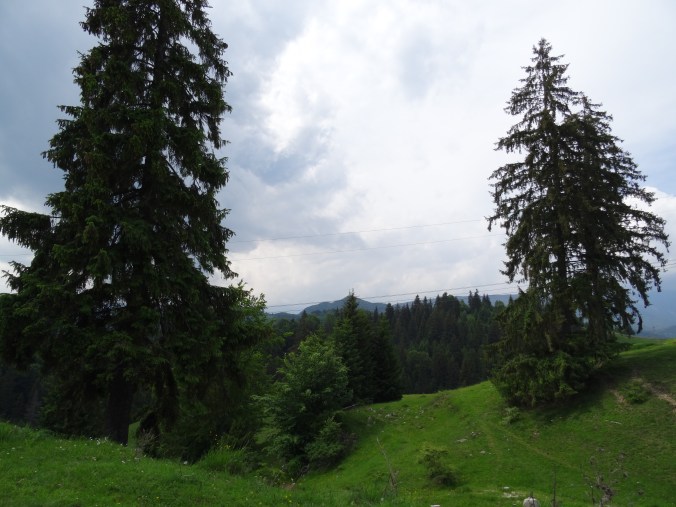

Somewhere between Argeș and Brașov counties
We arrived late into Curtea de Arges and headed straight for dinner, some super tough fried chicken. Moving onto a bar we were asked to sample new unpasteurised Timisoreana beer for free, which we gladly accepted!
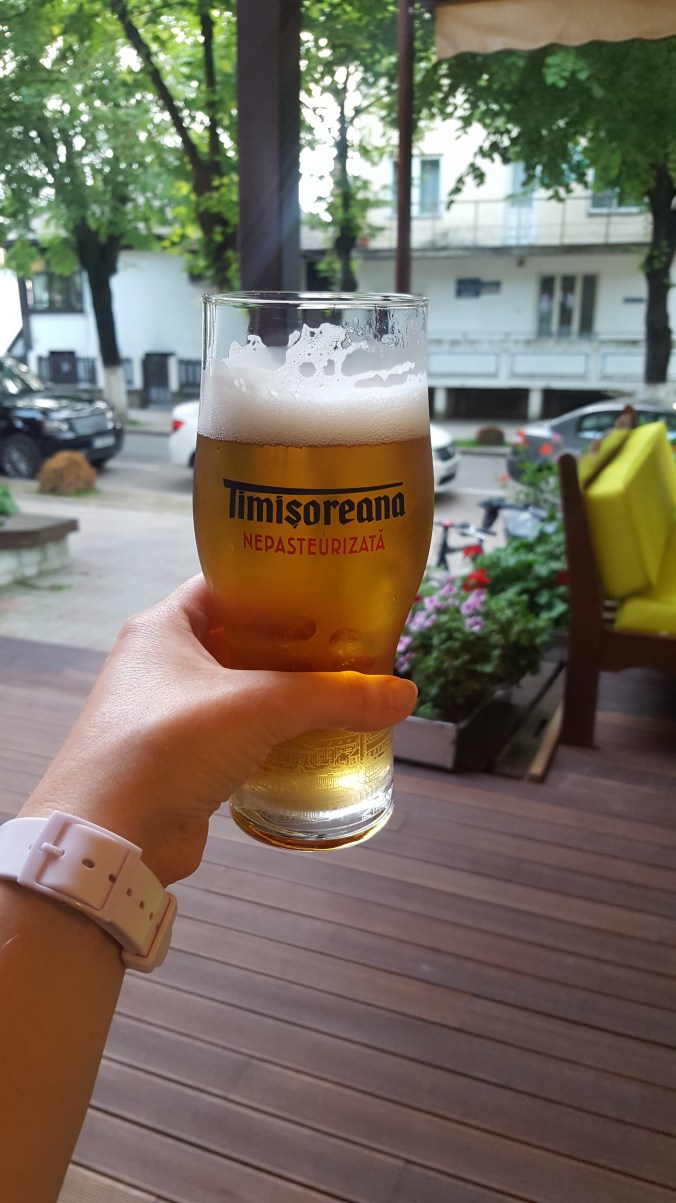
Free beer – cheers!
Day 6 – The Transfăgărășan Highway to Sibiu
Before leaving Curtea de Arges, I wanted to see the two main attractions, the cathedral, and the ‘Princely Court.
I’d mostly chosen Curtea de Arges as a stopping point for its geographical convenience at the start to the Transfăgărășan Highway so we wouldn’t have to do too much driving before we hit the twists and turns of the mountain pass. So everything we saw there would be a complete bonus on the trip.

Curtea de Argeș Cathedral
The Cathedral is a rather odd building for an Orthodox church, built in the Moorish style with many architectural elements that seem in keeping more with a mosque than a church.
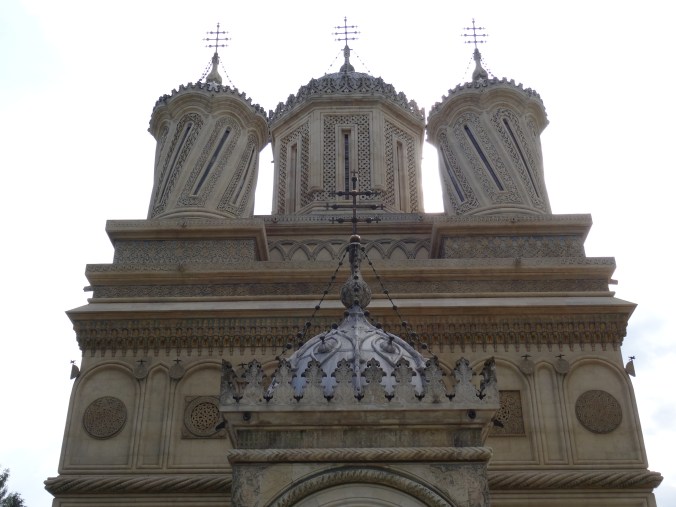
Curtea de Argeș Cathedral

Detail of Curtea de Argeș Cathedral
The turrets on the top have a twisting design and the pale limestone facing is punctuated by only the tiniest of windows.

Interior of Curtea de Argeș Cathedral
Inside is a complete surprise after the pale and light exterior, exceedingly dark and every inch covered with richly adorned paintings all gleaming with gold. The church dates from the early 16th century originally but was restored from a ruin in the late 19th century and given the facade it has now.

Interior of Curtea de Argeș Cathedral

Decoration inside Curtea de Argeș Cathedral
After this we walked back to the Princely court (they’re walking distance from each other so stay somewhere in between the two and you’ve got it made) to see the 13th and 14th century ruins of the court of Curtea de Arges back when it was the capital of Wallachia. 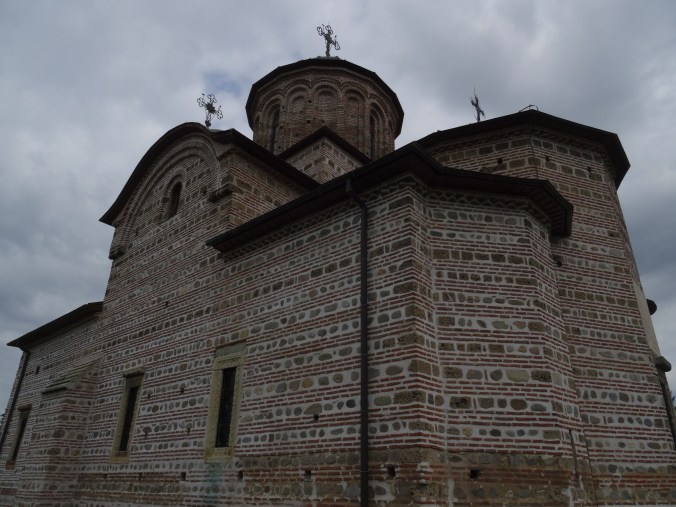
The chief attraction is St Nicholas’ Church, which dates from the time of Basarab I (1310–52). Most of the frescoes inside are contemporaneous with the building of the church and include some rare compositions.

Interior of Biserica Domnească Sfântul Nicolae
I’m always so awestruck by churches which are completely painted inside, especially since the English Reformation reduced all our extant churches and cathedrals to empty white washed shells.

Frescoes in Biserica Domnească Sfântul Nicolae, Dormition of the Virgin

Frescoes in Biserica Domnească Sfântul Nicolae
Half on hour later of staring open mouthed at this elaborate decorative scheme I conceded that I finally had enough photos and turned my attention to the road ahead.
The Transfăgărășan Highway was built as a strategic military route in the 1970s and also goes by the name of ‘Ceaușescu’s Folly’. It crosses the southern Carpathians climbing to an elevation of 2,000m. It was also apparently voted the ‘world’s best roadtrip’ by Top Gear, and when you drive it, it’s easy to see why.

Looking back down the Transfăgărășan Highway
I had seen from Google Maps, as well as searching online for information that the Transfăgărășan Highway (the 7C road) was not open all the way through yet, typically opening in June (we were just a couple of days into the month). A tired wooden notice board duly notified us that it was closed at km 79 (it runs from 1km up from the north to the south).
It seems that the road is generally open during July, August, September and October and then closes again when it gets blocked by snow. Still, we remained in hope that by some miracle it would be open, thus saving us a spectacular drive which would culminate in having to drive all the way back and round another route to Sibiu, adding 4 hours to our journey.
On the way to this famous road, we would pass Poenari Castle, the only one that actual does seem to have something to do with Dracula. This fortress sits atop a ridge (Mount Cetatea) at the start to the Transfăgărășan pass, up concrete 1,480 steps.
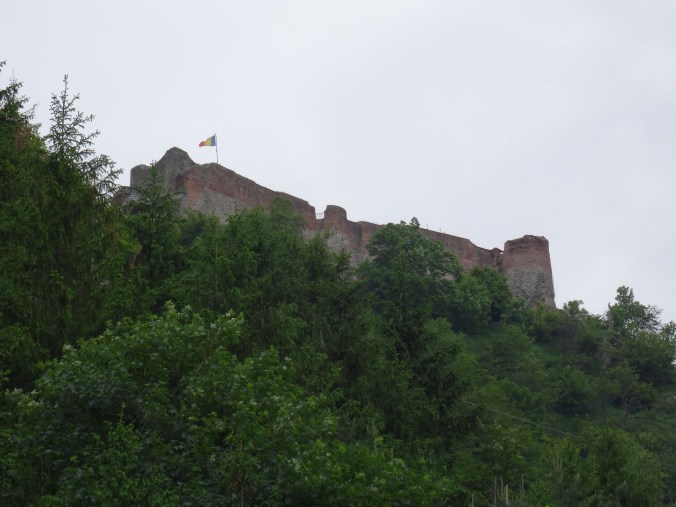
It was first built around the beginning of the 13th century but later abandoned until Vlad the Impaler took it over and repaired it in the 15th century. Alas, viewing the castle was not to be as a mother bear had seen fit to raise young somewhere near the path to the castle and so it was closed until the bears could be safely relocated to somewhere they couldn’t scare tourists.

Castle closed due to very orderly line of bears
So it was back in the car and time to finally sample the Transfăgărășan Highway. You don’t need to wait long for the ‘ooohs’ and ‘ahhhs’ with the road winding tightly around the sheer cliff faces towering each side and darting in and out of tunnels cut through the rock. You soon come to the dammed Lacul Vidraru with its beautifully green colour. 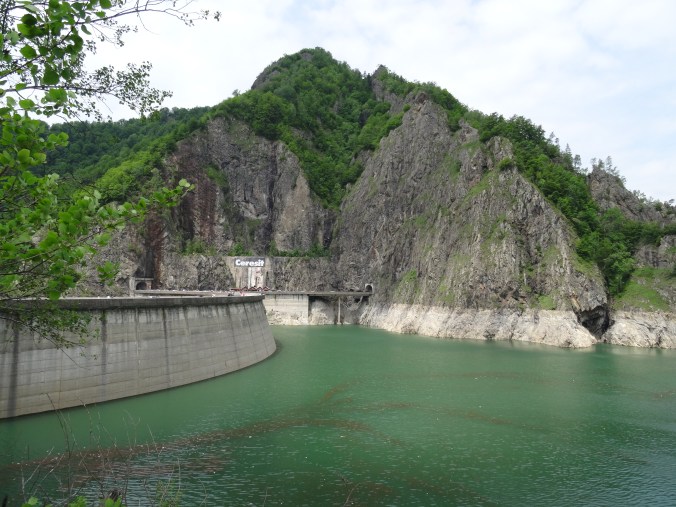
The road beyond the lake settles down into sweeping alpine vistas with some tight bends but nowhere near the treacherous conditions we had become used to in Romania. The road was oddly well maintained with few pot holes (except the ones they were currently filling) and fairly easy going corners. Although, in common with the rest of the country, you never quite know what will be in the road when you come round the corner.

Transfăgărășan rush hour
The next 30km or so were plain sailing until we became aware of the change in scenery as the altitude increased. Lush forest gave way to rock, gravel and barren grassy slopes. Grey cloud clung to the top of the pass and we could see seams of snow still on the rocks despite the 18 degree heat.
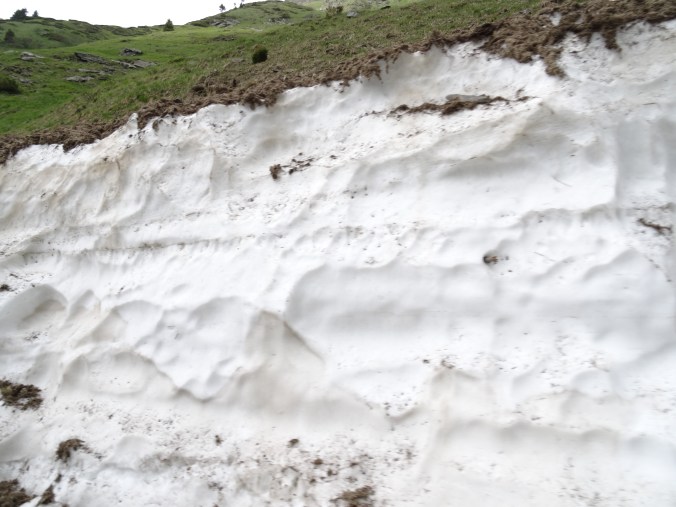
Deep snow lines the roads even in June
Higher we went until we were met with huge snow drifts across half the world, busily melting but still some weeks away from disappearing. We finally reached a queue of parked cars at the entrance to the tunnel through the mountains – that was the end of the line, our gamble hadn’t paid off. But we’d managed to get further than we thought and enjoyed amazing views over the mountains. After a tricky three point turn it was back the way we came.

Entrance to 884m long Bâlea Tunnel on the Transfăgărășan Highway
The drive back to Curtea de Arges to start our route to Sibiu was uneventful and far from a boring repeat of the same journey in reverse, was a great opportunity to take in the spectacular scenery once more.
We headed off towards Sibiu on another cute local road which round gently through small villages, all characteristically lined with hay stacks.
Soon, however, the paving disappeared and we found ourselves on a gravel road. No biggy, we’d done a few of those already. But not like this. The road quickly deteriorated into what I can only describe as a motor cross track. We bumped along in first gear, the car making ever stranger noises. Somehow a white van was speeding ahead of us – we never did catch him up – but we at least knew it would be possible to drive the road, despite the quizzical look from the cow herder we passed.

The road quality had improved significantly by the time I dared to take this picture
We eventually made it back onto a ‘proper’ road which was paved but resembled more the kind of road leading to a country estate than a main thoroughfare. I wish I’d taken photos to prove how bad that road was, because no one will ever believe me, but unfortunately I was too eagerly scanning the road ahead for pot holes and hanging on for dear life!
Moral of the story: check your routes ahead of time- if the little yellow Google man hasn’t been there, think twice. We earned that ‘no new damage’ verdict on our car rental return slip- I’ve even kept it as a souvenir!
Finally we arrived in Sibiu, a beautiful city and important cultural centre, holding the European Capital of Culture title in 2007. We watched the sunset from the main square and ate a traditional Romania meal of Sarmale – minced beef, pork and rice wrapped in cabbage leaves and served with sour cream.

Sibiu central square at sunset
Day 7 – the last day in Sibiu
Sibiu is a really attractive city with lots going on; plenty of shops, restaurants, churches and museums. Quite aside from that it’s just a really pretty and pleasant place to stroll around.

Sibiu central square
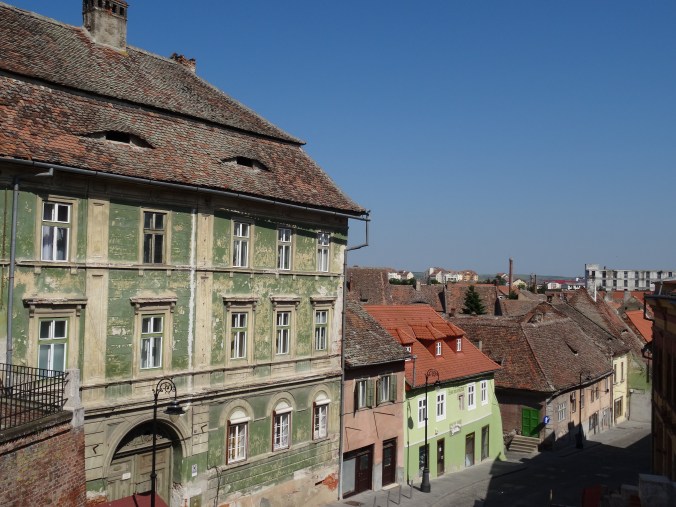
Houses in the Lower Town, Sibiu
After a busy week travelling around I was in the market for a good stroll and decided to have an easy day wandering around before my flight home, rather than attempting to sight-see too much. There are plenty of museums in Sibiu, however, and you could easily spend a few days there.
In Sibiu the roofs have eyes- apparently this is totally unique to this town. It’s a bit of a strange sight but highly photogenic!

Sibiu central square with characteristic ‘eyelid’ windows in the roofs
We also took a stroll around the old walls in the shade, stopping to look at the various remaining towers.

Tower in the fortified walls which surrounded the medieval city
All too soon it was time to head to the airport and end our week of driving in Romania. Such an amazingly beautiful country- I will definitely be back.
Travel tips for a road trip in Romania
Where should I visit in Romania?
I enjoyed everywhere I visited, although I especially enjoyed visiting the parts which were more off the beaten track. Places like Rasnov and Bran can be very busy with tourists which makes it feel like you could be in Paris or Rome; I found that part of what was so attractive about Romania was that the pace of life is rather slower and it doesn’t have an over-engineered tourist industry.
The easiest way to get around is to hire a car which will give you complete freedom to move around. Romania is overwhelmingly rural, so if you want to go beyond the main tourist sites, you will likely struggle to do it on public transport. A week’s rent cost us around £200 for a small car.
If wildlife is your thing, there are plenty of tour operators offering wildlife watching and longer tours which are across the country but often seem to be clustered around Brașov. I used Carpathian Nature Tours for an evening bear watching in a hide.
This is the route I followed over a 7 day stay:
When should I visit Romania?
Tourist season doesn’t kick off fully till summer; if you want to swim in lakes and get the full experience in holiday resorts, then you’ll have to stick to July and August. Also keep in mind it is more or less universally snowy in winter and some of the mountain roads won’t be open, which is likely to spoil your itinerary. Some roads, like the must-drive Transfăgărășan pass don’t even open until June or July
The weather was pretty consistent during my June stay, with the temperature generally around 25 – 30 degrees (depending on altitude) and sunny, with the odd evening thunderstorm.

Meadows on the way from Humor to Lake Bicaz
What is driving like in Romania?
Roads can be steep and treacherous, it doesn’t hurt to rent a car with a bit of power to take some of the frustration out of driving. Keep an eye on pot holes and the general road surface if you don’t like changing tyres on the side of a mountain.
Not all roads in Romania are paved, especially the country and communal roads. If you are not comfortable driving on bumpy, gravel roads then you may need to do some careful route planning before your trip, or hire a 4×4. We didn’t encounter problems, either with being able to drive the routes or damaging the car, but we were extremely close to grounding the car in some of the deeper holes and dips in an unpaved road and averaged about 15 kmph through that 8km section- it was very hairy driving.
Driving is otherwise fairly easy, other drivers tend to indicate and follow other rules of the road, they can just be a bit impatient when it comes to overtaking.

The road quality had improved significantly by the time I dared to take this picture
How easy is it to be understood in Romania?
Not everyone speaks English. English speakers are universally spoilt and you tend to assume that everyone can speak some. This is not always the case in Romania. Some people have excellent English, but since it’s not much of a British or American holiday destination yet, they’re more likely to speak French, German or Russian if they have a second language. At no point did this cause us any problems.
How long should I spend in Romania?
Romania is massive and driving is slow. It’s easy to be over ambitious with an itinerary when you know there’s so much good stuff to see and it’s so widely dispersed. I used Google maps to plan my trip and it was generally pretty accurate on driving times. I initially thought it was wrong when it said 3 hours to drive 180km, but with the steep and twisting mountain roads it really does slow you up. We covered 1300km in a week which was totally doable but about 3 hours driving a day. Make sure you build in time for stopping for photos and investigating interesting things you see on your way.
What is the food like in Romania?
I went to Romania straight after a week in Croatia and confess I was starting to struggle with constant Central / Eastern European cuisine. Food was generally a bit hit and miss but on balance we had more good meals than bad.
Pizza and pasta are more of less omnipresent, although is often a bit of a take on the Italian originals. The rest of the food is general Eastern European fare with pork and chicken as the staples. In common with many of its neighbours, one traditional dish is ‘sarmale’; minced pork and beef cooked in cabbage or grape leaves and served with polenta (as many things are) and sour cream. Various regions also have their own take on a tochitură, which seemed to be a dish of pork in every way you could imagine served with polenta (again), cheese and fried egg.
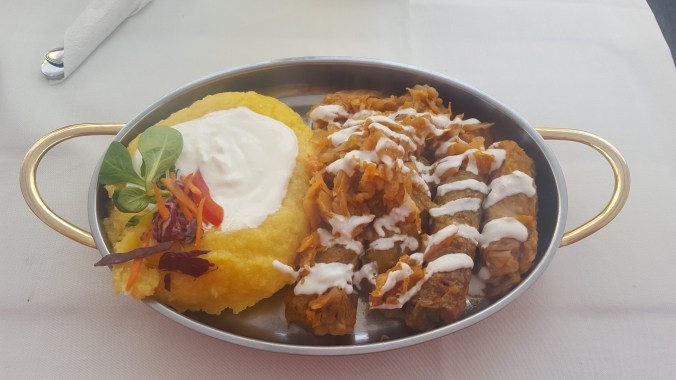
Sarmale, traditional Romanian dish
How much will a trip to Romania cost?
Budget carriers Wizz Air and Ryanair both fly from London to a variety of Romania’s airports, and BA flies into Bucharest. We flew into Cluj and out of Sibiu with Wizz Air. I booked my flights a bit late and they cost about 200 return each. Simple accommodation cost us between 20 and 30 pounds a night for a twin room; breakfast and dinner are usually extra but you typically walk away with a bill for 50 – 60 quid a night for two people. A few locations were pricier and there are often more expensive options if you’re in a larger town, but it’s possible to get by on a fairly limited budget. Our week’s car hire with different pick up and drop off locations was about £200.

Window in Sibiu




